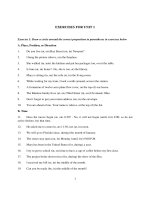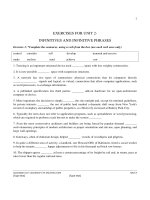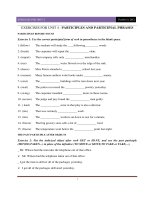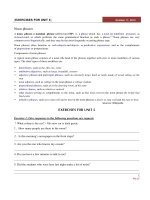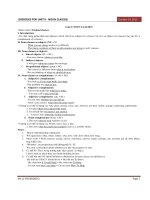Architecture English Exercise Unit 05
Bạn đang xem bản rút gọn của tài liệu. Xem và tải ngay bản đầy đủ của tài liệu tại đây (46.71 KB, 4 trang )
EXERCISES FOR UNIT 5
[
]
October 11, 2012
1
Ms LY
Noun phrases
A noun phrase or nominal phrase (abbreviated NP) is a phrase which has a noun (or indefinite pronoun) as
its head word, or which performs the same grammatical function as such a phrase.
[1]
Noun phrases are very
common cross-linguistically, and they may be the most frequently occurring phrase type.
Noun phrases often function as verb subjects and objects, as predicative expressions, and as the complements
of prepositions or postpositions.
Components of noun phrases:
A typical noun phrase consists of a noun (the head of the phrase) together with zero or more modifiers of various
types. The chief types of these modifiers are:
determiners, such as the, this, my, some
attributive adjectives, such as large, beautiful, sweeter
adjective phrases and participial phrases, such as extremely large, hard as nails, made of wood, sitting on the
step
noun adjuncts, such as college in the noun phrase a college student
prepositional phrases, such as in the drawing room, of his aunt
relative clauses, such as which we noticed
other clauses serving as complements to the noun, such as that God exists in the noun phrase the belief that
God exists
infinitive phrases, such as to sing well and to beat in the noun phrases a desire to sing well and the man to beat
Sources: Wikipedia
EXERCISES FOR UNIT 5
Exercise 1: Give responses to the following questions are requests
* What colour is his car? - His new car is dark green.
1. How many people are there in the room?
_____________________________________________________________________________________
2. Is this morning’s newspaper on the front steps?
_____________________________________________________________________________________
3. Are you the one who knows my cousin?
_____________________________________________________________________________________
4. Do you have a few minutes to talk to me?
_____________________________________________________________________________________
5. Did the students who were here last night make a lot of noise?
_____________________________________________________________________________________
EXERCISES FOR UNIT 5
[
]
October 11, 2012
2
Ms LY
6. Do you want a little sugar in your coffee?
_____________________________________________________________________________________
7. Is the attractive woman sitting on the bench your aunt?
_____________________________________________________________________________________
8. Do you live on the third or the fourth floor of the building?
_____________________________________________________________________________________
9. Was there enough chocolate cake for everyone?
_____________________________________________________________________________________
10. Is that distinguished, white-haired man talking to Dr. Kelly mathematics professor?
_____________________________________________________________________________________
11. Would you please carry these two heavy packages?
_____________________________________________________________________________________
12. Do you mind if I took a dozen copies of the conference report?
_____________________________________________________________________________________
13. Does she have an oval face or a round face?
_____________________________________________________________________________________
14. Do those magazines on the table in the hall belong to you?
_____________________________________________________________________________________
15. Do you have much money in your savings account?
_____________________________________________________________________________________
Exercise 2: Rewrite the following sentences, placing the adjective modifiers in parentheses in correct
positions
* That book is mine. (on the table, French)
That French book on the table is mine.
1. The table is on sale. (marble)
2. The man is a professor. (history, with the grey hair )
_____________________________________________________________________________________
3. The salesman sold a car to John. (used, who waited on you )
EXERCISES FOR UNIT 5
[
]
October 11, 2012
3
Ms LY
_____________________________________________________________________________________
4. Two knives are sharp. (steel, those, that are in the drawer )
_____________________________________________________________________________________
5. Yesterday I met interesting people. ( several, who work in television )
_____________________________________________________________________________________
6. The men are army officers. (wearing the uniforms, Australian )
_____________________________________________________________________________________
7. The question was difficult. (examination, third )
_____________________________________________________________________________________
8. There were clouds in the sky. (many, rain)
_____________________________________________________________________________________
9. The women wore evening dresses to the opera. (new, their )
_____________________________________________________________________________________
10. There isn’t ink in my pen. (much, fountain)
Exercise 3: *Read the following text and underline the noun phrases
HIGH-RISES
Also called High-rise, a multistory building tall enough to require the use of a system of mechanical
vertical transportation such as elevators. The skyscraper (q.v.) is a very tall high-rise building.
The first high-rise buildings were constructed in the United States in the 1880s. They arose in urban areas
where increased land prices and great population densities created a demand for buildings that rose
vertically rather than spread horizontally, thus occupying less precious land area. High-rise buildings were
made practicable by the use of steel structural frames and glass exterior sheathing. By the mid-20th
century, such buildings had become a standard feature of the architectural landscape in most countries in
the world.
The foundations of high-rise buildings must sometimes support very heavy gravity loads, and they usually
consist of concrete piers, piles, or caissons that are sunk into the ground. Beds of solid rock are the most
desirable base, but ways have been found to distribute loads evenly even on relatively soft ground. The
most important factor in the design of high-rise buildings, however, is the building's need to withstand the
lateral forces imposed by winds and potential earthquakes. Most high-rises have frames made of steel or
steel and concrete. Their frames are constructed of columns (vertical-support members) and beams
(horizontal-support members). Cross-bracing or shear walls may be used to provide a structural frame
with greater lateral rigidity in order to withstand wind stresses. Even more stable frames use closely
spaced columns at the building's perimeter, or they use the bundled-tube system, in which a number of
framing tubes are bundled together to form exceptionally rigid columns.
High-rise buildings are enclosed by curtain walls; these are non-load-bearing sheets of glass, masonry,
stone, or metal that are affixed to the building's frame through a series of vertical and horizontal members
called mullions and mountings.
EXERCISES FOR UNIT 5
[
]
October 11, 2012
4
Ms LY
The principal means of vertical transport in a high-rise is the elevator (q.v.). It is moved by an electric
motor that raises or lowers the cab in a vertical shaft by means of wire ropes. Each elevator cab is also
engaged by vertical guide tracks and has a flexible electric cable connected to it that provides power for
lighting, door operation, and signal transmission.
Because of their height and their large occupant populations, high-rises require the careful provision of
life-safety systems. Fire-prevention standards should be strict, and provisions for adequate means of
egress in case of fire, power failure, or other accident should be provided. Although originally designed
for commercial purposes, many high-rises are now planned for multiple uses. The combination of office,
residential, retail, and hotel space is common.
THE END
![Tài liệu English 7-Unit 7[1]. B2,3,4](https://media.store123doc.com/images/document/13/ce/bz/medium_bzb1379233290.jpg)

